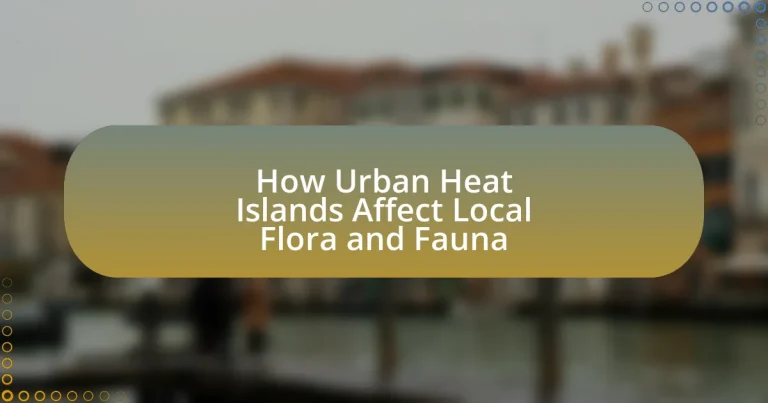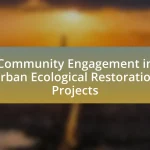Urban Heat Islands (UHIs) are urban areas that experience significantly higher temperatures than their rural surroundings due to human activities and land use changes. This article examines the formation of UHIs, the contributing factors such as urban materials and reduced vegetation, and their significant impacts on local ecosystems, including flora and fauna. It highlights how UHIs affect energy consumption, public health, and biodiversity, while also discussing the role of vegetation in mitigating these effects. Additionally, the article explores strategies for urban planning and community initiatives aimed at reducing UHI impacts and enhancing urban biodiversity.
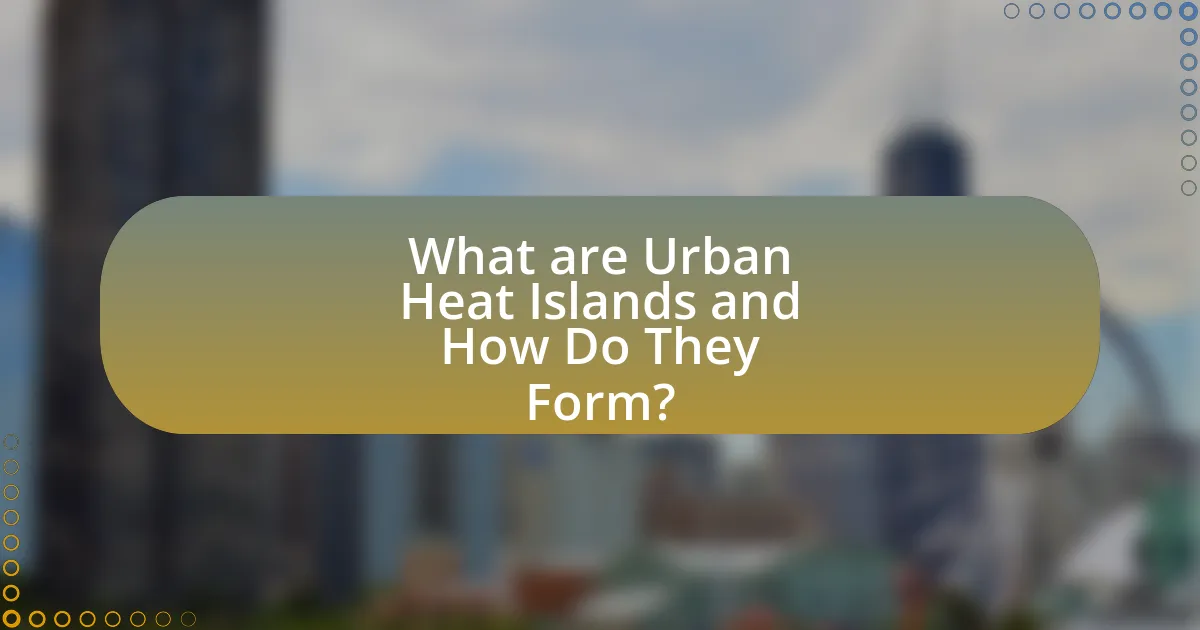
What are Urban Heat Islands and How Do They Form?
Urban Heat Islands (UHIs) are urban areas that experience significantly higher temperatures than their rural surroundings due to human activities and land use changes. They form primarily through the absorption and retention of heat by buildings, roads, and other infrastructure, which replace natural vegetation. This phenomenon is exacerbated by factors such as reduced vegetation cover, increased energy consumption, and waste heat from vehicles and industrial processes. Studies indicate that UHI effects can raise urban temperatures by 1 to 7 degrees Fahrenheit compared to nearby rural areas, impacting local ecosystems and biodiversity.
What factors contribute to the formation of Urban Heat Islands?
Urban Heat Islands are primarily formed due to factors such as increased absorption of solar radiation by built surfaces, reduced vegetation, and anthropogenic heat emissions. Urban areas, characterized by concrete, asphalt, and buildings, absorb and retain heat more than natural landscapes, leading to elevated temperatures. The lack of vegetation diminishes shade and evapotranspiration, which are natural cooling processes. Additionally, activities such as transportation, industrial processes, and energy consumption release heat, further exacerbating temperature increases in urban settings. Studies indicate that urban areas can be 2 to 5 degrees Fahrenheit warmer than their rural counterparts, highlighting the significant impact of these contributing factors.
How do urban materials influence temperature variations?
Urban materials significantly influence temperature variations by altering heat absorption and retention properties. Materials such as asphalt and concrete have high thermal mass, absorbing and storing heat during the day and releasing it slowly at night, which contributes to the urban heat island effect. Research indicates that urban areas can be 1 to 7 degrees Fahrenheit warmer than their rural surroundings due to these materials. Additionally, the color and texture of urban surfaces affect albedo, with darker surfaces absorbing more sunlight and increasing local temperatures. Studies, such as those conducted by the U.S. Environmental Protection Agency, demonstrate that the choice of materials in urban planning directly impacts microclimates and overall temperature profiles in cities.
What role does vegetation play in mitigating Urban Heat Islands?
Vegetation plays a crucial role in mitigating Urban Heat Islands (UHIs) by providing shade, enhancing evapotranspiration, and improving air quality. The presence of trees and plants lowers surface and air temperatures through shading and the cooling effect of moisture released during evapotranspiration, which can reduce local temperatures by up to 5 degrees Celsius. Studies have shown that urban areas with increased vegetation cover experience significantly lower temperatures compared to those with minimal greenery, demonstrating that strategic planting can effectively combat the heat generated by urban infrastructure.
Why are Urban Heat Islands significant in urban planning?
Urban Heat Islands (UHIs) are significant in urban planning because they exacerbate temperature extremes, impacting energy consumption, air quality, and public health. Research indicates that urban areas can be up to 5-7 degrees Fahrenheit warmer than surrounding rural areas due to UHIs, leading to increased energy demand for cooling and higher emissions of pollutants. This phenomenon necessitates strategic planning to incorporate green spaces, reflective materials, and sustainable design practices to mitigate heat effects and promote biodiversity, ultimately enhancing the resilience of urban ecosystems.
How do Urban Heat Islands impact energy consumption in cities?
Urban Heat Islands (UHIs) significantly increase energy consumption in cities by raising temperatures, which leads to higher demand for air conditioning and cooling systems. Research indicates that urban areas can be up to 5-7 degrees Fahrenheit warmer than surrounding rural areas, resulting in a 20-50% increase in energy use for cooling during peak summer months. This elevated energy demand not only strains electrical grids but also contributes to higher greenhouse gas emissions, as many cities rely on fossil fuels for electricity generation.
What are the implications for public health related to Urban Heat Islands?
Urban Heat Islands (UHIs) significantly impact public health by increasing heat-related illnesses and mortality rates. Research indicates that urban areas can be 1 to 7 degrees Fahrenheit warmer than surrounding rural areas, leading to higher instances of heat exhaustion, heat stroke, and exacerbation of pre-existing health conditions such as cardiovascular and respiratory diseases. A study published in the journal Environmental Health Perspectives found that extreme heat events, intensified by UHIs, are linked to increased hospital admissions and emergency room visits, particularly among vulnerable populations like the elderly and those with chronic health issues. Additionally, UHIs can worsen air quality by increasing ground-level ozone formation, which contributes to respiratory problems and allergies, further straining public health resources.
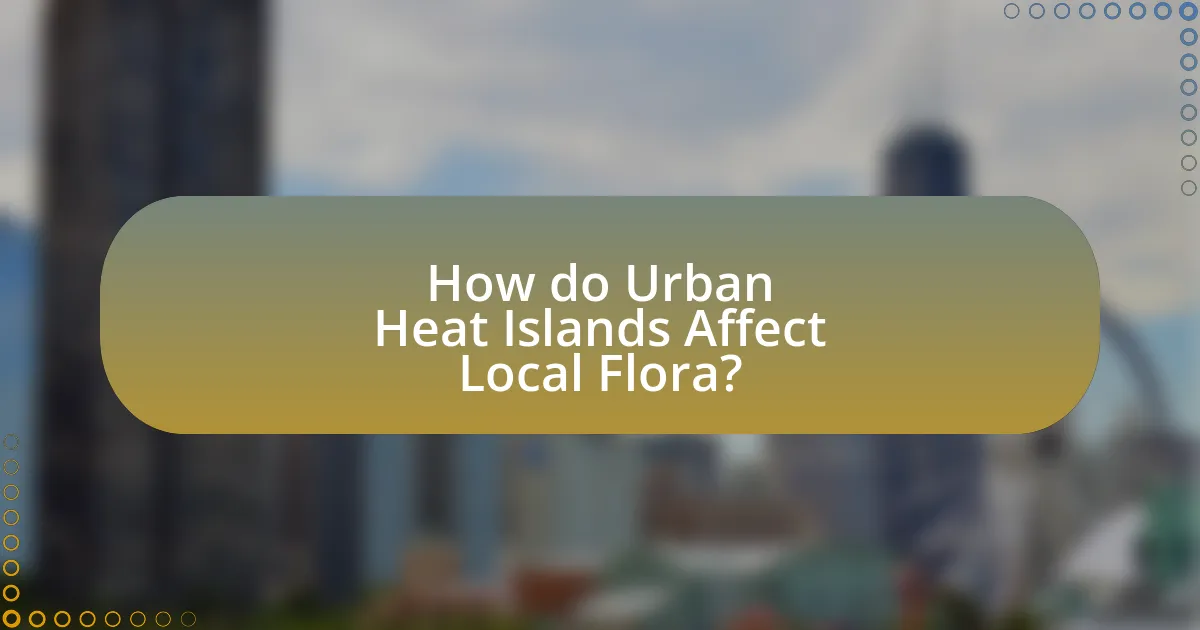
How do Urban Heat Islands Affect Local Flora?
Urban Heat Islands (UHIs) negatively impact local flora by increasing temperatures, which can lead to heat stress and altered growth patterns in plants. Elevated temperatures in urban areas can cause earlier flowering and leafing, disrupting the timing of plant life cycles and potentially leading to mismatches with pollinators. Research indicates that UHI effects can reduce plant diversity, as heat-sensitive species may decline while heat-tolerant species dominate, thereby altering local ecosystems. For example, a study published in “Environmental Research Letters” by Zhang et al. (2019) found that urban vegetation experienced significantly higher temperatures compared to rural areas, affecting species composition and health.
What changes occur in plant species distribution due to Urban Heat Islands?
Urban Heat Islands (UHIs) lead to shifts in plant species distribution by creating warmer microclimates that favor heat-tolerant species over those sensitive to temperature changes. Research indicates that urban areas can be 2 to 5 degrees Celsius warmer than surrounding rural areas, which alters the competitive dynamics among plant species. For instance, studies have shown that species such as the common dandelion and certain grasses thrive in these warmer conditions, while native species that require cooler temperatures may decline or be displaced. This shift can result in reduced biodiversity and changes in ecosystem functions, as the dominance of heat-adapted species alters habitat structure and resource availability.
How does increased temperature affect plant growth and reproduction?
Increased temperature negatively affects plant growth and reproduction by altering physiological processes and disrupting ecological balances. Higher temperatures can lead to increased respiration rates in plants, which reduces their overall growth and biomass accumulation. Additionally, elevated temperatures can cause heat stress, leading to reduced photosynthesis and impaired reproductive success, such as lower seed viability and fruit set. Research indicates that for every 1°C rise in temperature, crop yields can decrease by approximately 10% due to these stressors, as shown in studies by the Intergovernmental Panel on Climate Change.
What are the consequences for native plant species in urban areas?
Native plant species in urban areas face significant consequences, primarily due to the effects of urban heat islands, habitat fragmentation, and pollution. Urban heat islands increase temperatures, which can lead to heat stress and altered growth patterns in native plants, reducing their survival rates. Habitat fragmentation disrupts ecosystems, making it difficult for native species to thrive and reproduce, while pollution from urban environments can introduce harmful chemicals that negatively impact plant health. Studies have shown that urbanization can lead to a decline in native biodiversity, with some species becoming endangered or extinct due to these pressures.
How do Urban Heat Islands influence plant health and resilience?
Urban Heat Islands (UHIs) negatively influence plant health and resilience by increasing temperatures and altering microclimates. Elevated temperatures can lead to heat stress in plants, reducing their growth rates and overall vitality. For instance, studies have shown that urban vegetation often experiences higher temperatures than rural counterparts, which can result in increased transpiration rates and water stress. Additionally, UHIs can exacerbate air pollution levels, further impacting plant health by causing physiological damage and reducing photosynthetic efficiency. Research indicates that urban trees may suffer from increased pest infestations and diseases due to the stress induced by higher temperatures and altered environmental conditions.
What stress factors do plants face in hotter urban environments?
Plants in hotter urban environments face several stress factors, including increased temperatures, reduced water availability, and elevated pollution levels. Higher temperatures can lead to heat stress, which negatively impacts photosynthesis and growth. Reduced water availability occurs due to increased evaporation rates and limited soil moisture, making it difficult for plants to access necessary hydration. Additionally, elevated pollution levels, such as particulate matter and ozone, can harm plant health by causing leaf damage and reducing overall vitality. These stressors collectively contribute to the challenges plants encounter in urban heat islands, affecting their survival and ecosystem roles.
How can urban landscaping mitigate negative effects on flora?
Urban landscaping can mitigate negative effects on flora by incorporating native plant species, which are better adapted to local conditions and require less water and maintenance. This approach enhances biodiversity, improves soil health, and reduces the urban heat island effect by providing shade and cooling through evapotranspiration. Studies have shown that urban areas with diverse green spaces can lower surface temperatures by up to 5 degrees Celsius, thereby creating a more favorable environment for local flora. Additionally, strategic landscaping can improve air quality and reduce stormwater runoff, further supporting plant health and resilience in urban settings.
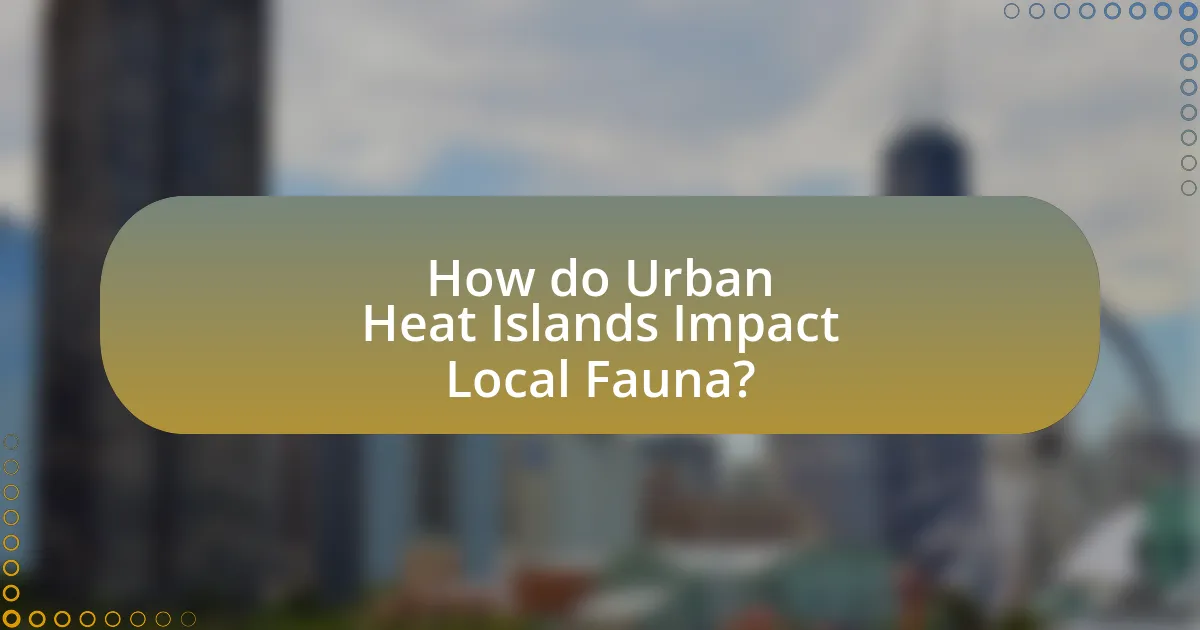
How do Urban Heat Islands Impact Local Fauna?
Urban Heat Islands (UHIs) negatively impact local fauna by altering their habitats and behaviors. Increased temperatures in urban areas can lead to heat stress in animals, affecting their reproduction, foraging, and survival rates. For instance, studies have shown that higher temperatures can disrupt the breeding cycles of amphibians and reptiles, which are sensitive to temperature changes. Additionally, UHIs can reduce the availability of food sources and suitable habitats, forcing wildlife to adapt or relocate, which can lead to decreased biodiversity. Research indicates that urbanization and the associated heat increase can lead to a decline in species richness, particularly among sensitive species, as they struggle to cope with the altered environmental conditions.
What are the effects of Urban Heat Islands on animal behavior and migration?
Urban Heat Islands (UHIs) significantly alter animal behavior and migration patterns. The elevated temperatures in urban areas can lead to changes in reproductive cycles, foraging behavior, and habitat selection among various species. For instance, studies have shown that birds may alter their migration timing to align with warmer temperatures, potentially leading to mismatches with food availability. Research published in “Ecological Applications” by Z. H. H. et al. (2020) indicates that urban environments can cause shifts in species distributions, as animals seek cooler microhabitats or migrate to less urbanized areas. Additionally, increased temperatures can stress wildlife, leading to changes in social structures and increased competition for resources.
How do temperature changes affect animal breeding cycles?
Temperature changes significantly influence animal breeding cycles by altering reproductive timing and success rates. For instance, many species rely on specific temperature thresholds to trigger hormonal changes necessary for breeding. Research indicates that warmer temperatures can lead to earlier breeding seasons in species such as amphibians and birds, as observed in studies conducted by the National Audubon Society, which found that migratory birds are nesting earlier due to increased temperatures. Additionally, temperature fluctuations can affect the availability of food resources, which in turn impacts the health and reproductive success of animals. For example, a study published in the journal “Ecology Letters” highlighted that rising temperatures can disrupt the synchronization between the breeding of certain species and the peak abundance of their prey, leading to decreased survival rates of offspring.
What adaptations do urban wildlife exhibit in response to heat islands?
Urban wildlife exhibit several adaptations in response to heat islands, including behavioral changes, physiological adjustments, and habitat selection. For instance, many species alter their activity patterns, becoming more nocturnal to avoid daytime heat, which is evidenced by studies showing increased nighttime foraging in birds and mammals. Additionally, some urban wildlife develop physiological traits, such as enhanced heat tolerance or altered water retention capabilities, to cope with elevated temperatures. Habitat selection also shifts, with animals preferring shaded areas or green spaces that provide cooler microclimates, as demonstrated by research indicating that urban birds favor parks over built environments during hot weather. These adaptations are crucial for survival in increasingly urbanized landscapes affected by heat islands.
How do Urban Heat Islands alter habitat availability for local fauna?
Urban Heat Islands (UHIs) reduce habitat availability for local fauna by increasing temperatures in urban areas compared to surrounding rural regions. This temperature rise can lead to habitat degradation, as many species are sensitive to temperature changes and may struggle to survive in altered environments. For instance, studies have shown that elevated temperatures can disrupt breeding cycles, food availability, and migration patterns of various species, ultimately leading to decreased biodiversity. Additionally, the urban landscape often lacks the natural vegetation and resources that many local fauna depend on, further limiting their habitat options.
What challenges do urban environments pose for wildlife survival?
Urban environments pose significant challenges for wildlife survival, primarily due to habitat loss, pollution, and increased human-wildlife conflict. Habitat loss occurs as urban development replaces natural landscapes, reducing the available space for wildlife to thrive. Pollution from vehicles, industrial activities, and waste contributes to degraded air and water quality, which adversely affects the health of various species. Additionally, urban areas often lead to increased encounters between humans and wildlife, resulting in conflicts that can be detrimental to animal populations. For instance, studies have shown that urbanization can lead to a decline in biodiversity, with some species unable to adapt to the altered environments, further threatening their survival.
How can urban planning support biodiversity in heat-affected areas?
Urban planning can support biodiversity in heat-affected areas by integrating green spaces, promoting native vegetation, and implementing sustainable water management practices. These strategies help mitigate the urban heat island effect, which raises temperatures and negatively impacts local flora and fauna. For instance, the incorporation of parks and green roofs can lower surface temperatures and provide habitats for various species, enhancing biodiversity. Research indicates that urban green spaces can reduce temperatures by up to 5 degrees Celsius, which is crucial for maintaining ecological balance. Additionally, using native plants in landscaping supports local wildlife by providing food and shelter, thereby fostering a resilient ecosystem in urban environments.
What strategies can be implemented to mitigate the effects of Urban Heat Islands on local ecosystems?
Implementing strategies such as increasing urban vegetation, utilizing reflective materials, and enhancing water bodies can effectively mitigate the effects of Urban Heat Islands (UHIs) on local ecosystems. Increasing urban vegetation through tree planting and green roofs can lower surface and air temperatures, as vegetation provides shade and facilitates evapotranspiration, which cools the surrounding environment. The use of reflective materials, such as cool roofs and pavements, can reduce heat absorption in urban areas, leading to lower ambient temperatures. Additionally, enhancing water bodies, such as lakes and ponds, can provide cooling effects and support local biodiversity by creating habitats for various species. Research indicates that urban greening can reduce surface temperatures by up to 5 degrees Celsius, demonstrating its effectiveness in combating UHI effects.
How can green infrastructure contribute to reducing Urban Heat Islands?
Green infrastructure can significantly reduce Urban Heat Islands (UHIs) by increasing vegetation cover, which lowers surface and air temperatures. Vegetation, through processes like evapotranspiration, cools the surrounding environment, mitigating the heat generated by urban surfaces such as asphalt and concrete. Studies indicate that urban areas with increased tree canopy can experience temperature reductions of up to 5 degrees Fahrenheit compared to areas with minimal greenery. Additionally, green roofs and permeable pavements contribute to cooling by absorbing rainwater and reducing heat absorption. These strategies not only lower temperatures but also enhance biodiversity, providing habitats for local flora and fauna affected by UHIs.
What role do community initiatives play in enhancing urban biodiversity?
Community initiatives play a crucial role in enhancing urban biodiversity by fostering local engagement and promoting sustainable practices. These initiatives often involve community gardens, tree planting, and habitat restoration projects, which directly contribute to increasing green spaces and supporting various species. For instance, a study by the University of California found that urban gardens can increase local pollinator populations by providing essential habitats and food sources. Additionally, community-led efforts to reduce urban heat islands, such as increasing vegetation cover, can mitigate temperature extremes, further benefiting local flora and fauna.
